Diving into the Impact: How Melting Ice Affects Dolphins in a Changing Climate
The majestic dolphin, known for its intelligence and grace, is not just a beloved marine mammal; it is also an integral part of our ocean ecosystems. However, as our climate shifts and ice caps melt, these extraordinary creatures face unprecedented challenges that threaten their habitats and survival. Understanding the effects of climate change on dolphins invites us to reflect on the broader environmental crisis and its deep implications for marine life.
Dolphins reside in diverse ocean environments, many of which are closely tied to the ice-covered regions of the Earth. The melting of polar ice and glaciers due to rising global temperatures affects sea levels and alters the salinity of ocean waters. As these changes occur, the delicate ecosystems that dolphins depend on begin to shift. Fish populations, crucial for dolphins’ dietary needs, are influenced by alterations in water temperature and current patterns. As their prey migrates to find optimal conditions, dolphins may struggle to adapt, leading to changes in feeding behaviors and migration patterns.
Moreover, melting ice contributes to the loss of essential habitats such as sea ice and coastal wetlands. Dolphins, especially species like the beluga and orca, rely on these icy waters for breeding and nurturing their young. The loss of sea ice means fewer safe spaces for dolphins to reproduce, impacting population numbers over time. Furthermore, as ice melts, coastal areas are increasingly exposed to human activities such as shipping, oil drilling, and tourism, further threatening dolphin populations.
Climate change also brings about more extreme weather events—hurricanes, heavy rainfall, and rising temperatures—that can disrupt entire marine habitats. These shifts can lead to increased ocean pollution and the introduction of harmful algal blooms, which can be toxic to dolphins. The waterways that were once rich in life now become hostile, forcing these magnificent creatures to navigate a rapidly deteriorating environment.
The emotional and psychological toll on dolphins cannot be overlooked. These social animals form deep bonds within their pods, and any disruption in their environment can lead to stress and disorientation. The impact of climate change not only disrupts their hunting grounds but also threatens their social structures, altering the dynamics of their communities. Such changes can lead to decreased reproduction rates and even increase mortality among calves, as the nurturing behaviors of mothers may be compromised.
We cannot ignore the responsibility we hold as stewards of our planet. The plight of dolphins in a changing climate serves as a powerful reminder of the interconnectedness of all life. As we work towards sustainable solutions to combat climate change, we must also advocate for the protection of our oceans and the remarkable creatures that inhabit them. From reducing plastic waste to supporting renewable energy initiatives, every action counts in creating a healthier environment for dolphins and future generations.
By understanding the impact of melting ice on dolphins, we are compelled to take action. As we dive deeper into this issue, let us remember the grace of the dolphin that thrives in a balanced ecosystem, and let us strive to restore harmony to the waters they call home.



